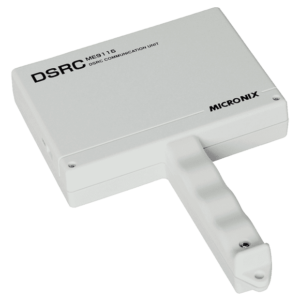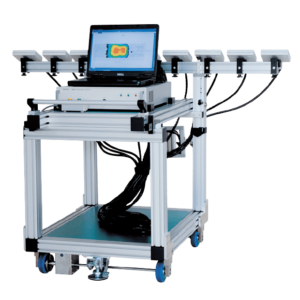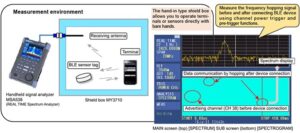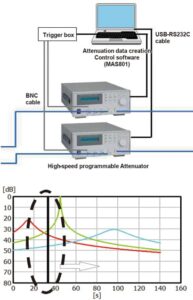Application
In the ETC/DSRC system, the unit of electric field strength is specified as dBmeirp as described in ARIB STD-75, which is a standard for dedicated short range communication (DSRC) system. Therefore, dBmeirp is used as the unit of electric field strength in DSRC communication unit ME9115 and ETC/ITS spot electric field strength measurement system ME9200 which are our products.
V/m or μV/m (dBV/m or dBμV/m in the case of dB expression) is generally used as the unit of electric field strength. The relationship between these units will be explained.
As a preliminary step to explain this relationship, the relationship between these units and antenna gain (absolute gain) and antenna factor used for field strength measurement will be explained. "eirp" in dBmeirp means equivalent isotropic radiant power. The electric field strength (dBmeirp) is obtained by subtracting the antenna gain (dBi) from the output power (dBm) of the receiving antenna.
The expression is as follows.
The electric field strength (dBmeirp) = The output power (dBm) - The antenna gain (dBi) …(1)
As the gain increases, the output power also increases.
Therefore, for example, when the receiving antenna with a gain of 2dBi is connected to the spectrum analyzer and measured to be -38dBm, the electric field strength at the surface of antenna is -40dBmeirp. (The cable loss between the receiving antenna and the spectrum analyzer is assumed to be zero for simplicity.)
On the other hand, when the electric field strength (dBμV/m) is also expressed as described above, the antenna factor (dB/m) is added to the output voltage (dBμv) of the receiving antenna.
The expression is as follows.
The electric field strength (dBμV/m) = The output voltage (dBμv) - The antenna factor (dB/m) …(2)
As the antenna factor increases, the output voltage decreases.
Therefore, for example, when the receiving antenna with an antenna factor of 44dB/m is connected to the spectrum analyzer and measured to be 68.5dBμV, the electric field strength at the surface of antenna is 112.5dBμV/m. (The cable loss between the receiving antenna and the spectrum analyzer is assumed to be zero for simplicity.)
When the measurement is carried out with 50Ω impedance, the following expression is obtained.
The output voltage (dBμv) = The output power (dBm) + 107 (dB) …(3)
Also, if 50Ω impedance and radio wave frequency 5.81GHz, the following expression is obtained.
The output voltage (dBμv) = The output power (dBm) + 107 (dB) …(3)
From the expressions of (1), (2), (3) and (4), the following expression is obtained.
The electric field strength (dBμV/m) = The electric field strength (dBmeirp) + 152.5(db/m) (@5.81GHz)
{ =The output power(dBm) + 107(dB) + 45.5(dB/m) - The antenna gain(dBi) }
System configuration
| DSRC communication unit ME9115 | ×1 |
| or | |
| ETC / ITS spot electric field strength measurement system ME9200 | ×1 |
Products introduction
DSRC Communication Unit ME9115
Making it possible to read WCN of OBE and to measure electric field strength of OBE and RSU.
ETC / ITS Spot Electric Field Strength Measurement System ME9200
ME9200 makes possible to measure the electric field strength of the signal radiated from ETC or ITS spot in a short time. With this system, after measuring the electric field strength distribution of the ETC/ITS spot with operation wave or CW in a short time, the electric field strength graph and the map diagram are created.

Please feel free to contact us.
If you want to verify 5G, customize a radio wave shield box, or need product repair, please do not hesitate to contact us about any small matter.




